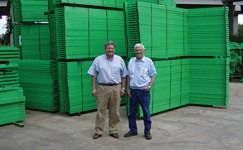Scaffolding
Justin Breithaupt Sr., founder of Non-Stop Scaffolding, is an innovative leader whose efforts have benefited and complemented the masonry industry for more than 50 years.
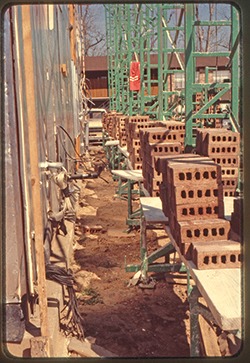
Masonry recently had the opportunity sit down, with one of the difference makers in the construction and masonry industries, Justin Breithaupt Sr., founder of Non-Stop Scaffolding. Many materials and types of equipment have evolved and improved over the years, scaffolding included. Breithaupt’s story spans not only changing times and rapid innovation over several decades, but also a long and solid relationship with the Mason Contractors Association of America.
Breithaupt actually was a mason contractor before he became a scaffold manufacturer. His father was a mason contractor, and he and his brothers grew up in the trade. He started his own company after college in 1954 at the age of 24. Breithaupt began working in residential work, but eventually moved into commercial work. The rest, as they say, is history.
Masonry: Why did you decide to design your own scaffolding?
Breithaupt: Well, the concept actually came from my first experience with corner poles, “speed poles” as we call them. I was close to finishing a 50-unit senior living complex – one-story brick veneer everywhere. It was pretty cut up, so we were building a lot of leads. One of my men, Homer, told me about working with a friend of his over the weekend, and using corner poles instead of building leads. He said they really made the work go faster.
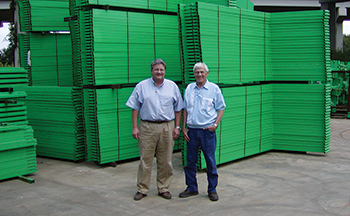
It got me thinking, so I started timing myself to see how many brick a minute I laid when building leads, compared to laying between the leads. I realized I laid three times as many brick between the leads.
Homer brought some speed poles out to the job the next day, and we used them. We almost doubled our production on the rest of that job, just by not building leads. I figured out how much money they saved me, and realized I had just left the price of two Cadillacs in that job! We never built a lead again.
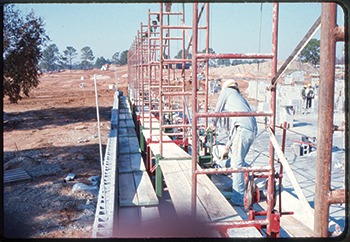
That experience taught me the most important lesson I ever learned: The labor number in a job is huge, compared to the profit number. Every penny saved in labor goes directly to profit. If you shave as little as 20 percent off your labor, your profit more than doubles. It was a revelation.
It taught me to look for ways to keep my bricklayers putting units in the wall at all times. When I was timing myself laying brick between the leads, the wall happened to be waist high. It was really comfortable, and fast! I remember thinking, “Man, this is easy; I could do this all day.” I multiplied those brick per minute out into an eight-hour day, and it was somewhere around 1,700 brick a day. That showed me I didn’t need to work faster, just consistently, without stopping, and at a comfortable height. In real life, very little of my work was in that sweet spot, but it showed me what was possible.
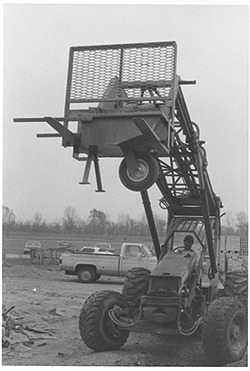
With that idea in mind, I started looking at my scaffolding, and what I saw just made me sick. My bricklayers would run a wall scaffold high, and then stop and move somewhere else. I timed that stop and it was always 20 to 30 minutes: a big waste of time and money.
Once they were on the scaffold, they worked from their ankles to their shoulders. Then, they stopped again to let the laborers hop the walkboards and materials up. That was another 20 to 30 minutes of down time. The bottom line is that using conventional frames was a horrible way to lay brick. But back then, that’s all we had.
Now, I knew they were laying my profit in the last hour of the day. If I could recapture just two of those stops to add 50 or 60 minutes of production time back into my day, I would almost double my profit. It would be production in the wall with no costs against it – pure profit.
When I saw Morgen scaffolding advertised, I understood it right away. I knew their claim of 20 percent more production was really conservative. I knew we could do a lot better than that – probably at least 35 percent.
So, I rented some. Sure enough, the extra production was there, and I more than doubled my profit on the job. But, my men hated it; it was so shaky. And I wasted a ton of money with the laborers taking the x-braces out and putting them back in going up, and then removing and replacing them again letting the scaffold down. It swayed so much my bricklayers said they would never get on it again.
Well, that experience taught me what I wanted in elevating scaffolding, and what features would make us the most money. There wasn’t anything on the market that fit the bill, so I sat down and designed my own.
Masonry: What features were the most important to you?
Breithaupt: Well, the first thing was being able to start the wall off the scaffold, so you never move your men until you top out. I designed it so you bring the scaffold in first, and deck it and stock it before you even lay out. The bricklayers walk on the dirt and pick their materials off the scaffold. The laborers start out on the scaffold. When the wall gets waist high, the bricklayer pulls out an outrigger, drops his walkboards down, and keeps working. I cut a 20- to 30-minute interruption in production down to 30 seconds. That’s right, 30 seconds.
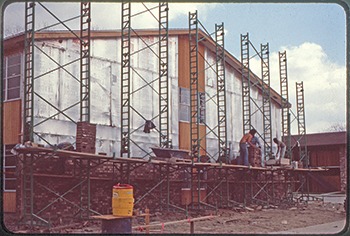
I was shocked to discover we could top out 20-foot-high walls in a day, so the second thing I had to have was the ability to let the scaffold down and move it to the next wall in a hurry, without having to take all the cross braces out and put them back in again. That scaffold wasn’t going to make me a nickel, until it was down and ready to go to work again. The only solution was constructing the elevating carriages in such a way that the x-braces could stay in place all the time. I had to make them in left- and right-hand configurations, so there was a gap the x-braces could pass through.
When I did that, I stumbled onto one of the best features we have: Cut-up work sets up just as fast as straight walls. You see, Morgen got everyone thinking that the best place for crank-up scaffolding is long, straight walls, and too many people still think that way today. That was true for Morgen, and these new mast-climbers, but not for the scaffolding I built.
When you’re setting up independent towers that don’t have to be tied together, it makes no difference whether it’s straight, cut up, or even radius walls. It all goes in place incredibly fast. You can pick up a tower with your forklift, boards and all, and land it at the next wall in about 10 minutes flat. Inside and outside corners set up the same speed as straight walls.
Masonry: Besides increasing production, what other features did you design into your scaffolding?
Breithaupt: A lot of them actually. The main thing was small parts getting lost. I had to keep my guys from making endless trips to the hardware store. Where I had to have a bolt, I designed it so it was trapped and couldn’t get lost. I used flip locks instead of bolts and wing nuts to attach the braces.
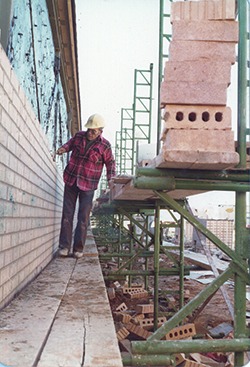
I designed it so it’s easy to move from job to job, without taking it all apart. Morgen and other systems rely on 18 wheeler-mounted racks. I designed that out.
There were other things, too, like making the towers twice as wide as Morgen, so it wouldn’t sway, and making a geared winch instead of a come-a-long. I even made my own solid steel screw jacks with a left-hand thread to make it easier for my right-handed laborers.
I just kept improving until my foremen quit complaining, and started asking for the scaffolding for their jobs. I knew I’d hit pay dirt, because it never came back to the yard.
Masonry: Explain the role that the MCAA has played in your decades-long growth and success.
Breithaupt: I joined the MCAA back in the ‘60s. I learned so much from the yearly meetings. They had educational seminars on all the information I needed: contracts, estimating, OSHA – it was invaluable. I met masonry contractors from all over and learned their tricks of the trade.
A general contractor from Iowa came down here to Shreveport, La., to build a big shopping mall. I called one of the masonry contractors from Iowa I’d met, and asked him about this general contractor. He gave me some pointers that helped me get that job, and increased my profit substantially.
Another time, I went down to Alexandria, La., to do a job and got into a heated discussion with the carpenters’ union. They were claiming I had to hire them to erect and dismantle all my scaffolding. I called George Miller, the head of the MCAA, and he told me exactly how to handle it. I referred them to a recent national agreement that gave the scaffolding to the laborers, and all my problems went away.
In today’s world, I think the MCAA is the most valuable resource a masonry contractor could have. It will put you light years ahead of your competition.
Masonry: What are your benchmarks to know you are providing contractors with what they need on the jobsite?
Breithaupt: Two things: We listen, and we’ve been there. Our field reps go out on almost every new installation to train the men. If there’s a quality issue, or a suggestion from the field, we hear about it immediately. We know what our customers need, and we give it to them.
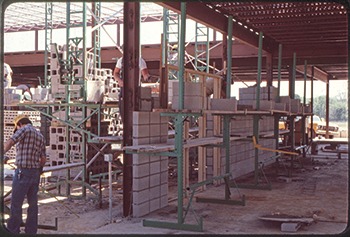
For instance, in the ‘90s, we started hearing our customers say they wanted to crank the scaffold down faster, so they could get it back to work quicker. I can imagine another manufacturer not having a clue how important that is, and not acting on it because the fix requires a major redesign. But we immediately got to work on a two-speed winch that could be shifted into high gear to let the scaffold down with about one-third as many cranks as it took to go up. It wasn’t too hard to do, since we make our own gears. Our customers loved it.
Later on we began hearing customers say they wished it was easier to crank. That issue was near and dear to my heart, because the Morgen was so hard to crank that the laborers would let the bricklayers run out of materials to make it easier to jack up. We got right on it and changed the gearing. Now you can land a pallet of split-faced 12s on the back and crank it one-handed. Our winch has twice the lifting power of anyone else’s.
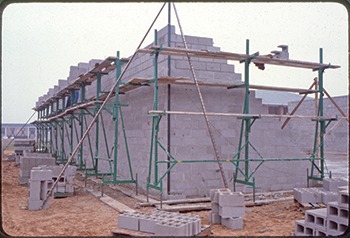
Masonry: What do you see for the masonry industry, and for Non-Stop, in the next few years?
Breithaupt: Well, everyone we talk to now is covered up with work, with no end in sight. I think they’re confident about the future, because they are buying equipment again. We’re at full capacity, and used Non-Stop is practically impossible to find. We’re going to keep on putting out good equipment and taking care of our customers.
Masonry: Any advice for new contractors getting into the business?
Breithaupt: Yes, two things: Join the MCAA, and go to every Annual and Midyear Meeting you can. Make the time.
The second thing is, get yourself some elevating scaffolding. It’ll completely pay for itself in just a few months, and it’ll never get parked on the yard.
That reminds me of a conversation I had with an electrical contractor friend years ago. He said, “Justin, Bill says you’re taking work too cheap and you’re going to go broke.” Bill was my main competitor in the ‘70s. I told my friend, “I don’t think so. I’m beating Bill by 5 percent and making about 20 percent on every job I do. I told him he ought to get some elevating scaffolding, and I’m not going to tell him again.”
